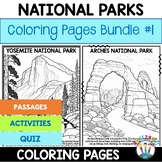76 results
Higher education physical science study guides for Microsoft Word

Atomic Structure - Bohr Model and Lewis Dots
This simple grid prompts students to use the periodic table to identify atomic number, atomic mass, protons, neutrons, and electrons. They then will draw the correct Bohr Model of the first 16 elements and draw the corresponding Lewis Dot Diagram with appropriate number of valence electrons. A blank page is provided so you can customize the worksheet for larger elements. An example has also been completed along with tips for completing each section.
Subjects:
Grades:
6th - 12th, Higher Education, Adult Education
Types:

General Science Praxis "DISCUSSION QUESTIONS" Study Guide
Need to get that extra certification to help you in the job field? Say no more!
Study this and prepare for that pesty praxis exam.
I completed a study guide that covers the DISCUSSION AREAS for the General Science 7-12 (5435) from this PDF from the Praxis Website: https://www.ets.org/s/praxis/pdf/5435.pdf
> I passed for my state standards from studying this study guide I made! Good luck, studying one page a day helps!
MY STUDY TIPS:
• Study every day.
• Study a page a day, and also go
Grades:
7th - 12th, Higher Education, Adult Education
Types:
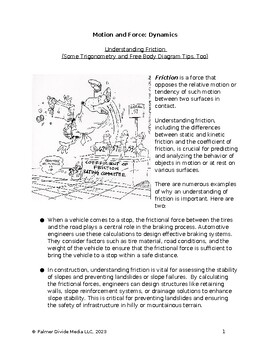
Motion and Forces - Dynamics: Understanding Friction
Students in high school physics courses often have initial challenges in understanding how friction works and how to calculate the magnitude of the friction force, the types of friction forces, and the role of the friction coefficient. This handout provides a succinct overview. It also includes an overview of how to use trigonometry to solve physics problems where the object is on an incline and tips on how to make free body diagrams.
Subjects:
Grades:
9th - 12th, Higher Education
Types:
NGSS:
HS-PS2-1
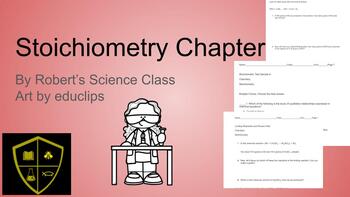
Stoichiometry Chapter
This is a collection of assignments, a quiz, and a sample test about stoichiometry.
Subjects:
Grades:
10th - 12th, Higher Education, Adult Education
Types:
CCSS:

Chemical Bonding Quiz
I have a quiz about chemical bonding. It would also be a good pre-unit quiz to see how much your students know about the subject. It has questions over orbitals, bonds, energy levels, and subatomic particles.
Subjects:
Grades:
10th - 12th, Higher Education, Adult Education
Types:
CCSS:
Also included in: My Total Store as of 5/26/24
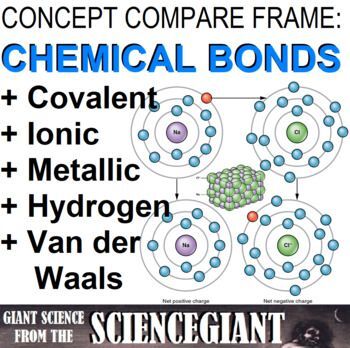
Concept Comparison and Frame: Ionic, Covalent, and Metallic Bonds in Molecules
This concept comparison is between chemical bonding of molecules and compounds. Help Ss contrast ionic and covalent bonding, as well as metallic bonds and Van der Waals forces (hydrogen bonds, dipole-dipole, London dispersion and Debye) . Also includes a chemical bond triangle graphic to help visualize differences in electronegativity The Concept Comparison Routine is used help compare and contrast key concepts. Specifically, students use like and unlike characteristics and categories shared an
Subjects:
Grades:
8th - 10th, Higher Education
NGSS:
HS-PS1-4
, HS-PS1-2
, MS-PS1-1
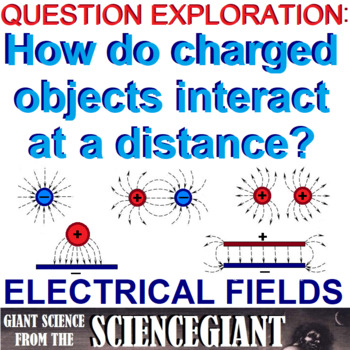
Question Explore: Electric Field Strength and How Charged Objects Interact
How do electrically charged object interact at a distance? This Question Exploration explains to Ss how an electric field exists around any charged unit. The field produces forces on other charged objects. This question exploration helps provide a picture of the electric field strength, and how charged objects interact at a distance.Question Exploration Routines are an instructional method that teachers can use to help a diverse student population understand a body of content information by care
Subjects:
Grades:
9th - 12th, Higher Education
NGSS:
MS-PS2-3
, HS-PS2-4
, MS-PS2-5
Also included in: StayGiant Physics Bundle: Electricity
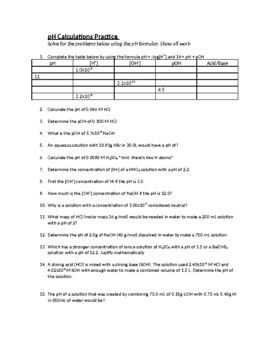
pH and pOH Calculations Practice
15 practice problems covering the strong acid and base pH calculations using the formulas pH = -log[H+] and 14 = pH + pOH. Students will calculate pH, pOH, ion concentrations, and compound mass. Answers and solutions are provided. Doc can be edited by adding, removing, or modifying to fit your lessons.ESL VersionKoreanSpanish
Subjects:
Grades:
8th - 12th, Higher Education, Adult Education
Types:
Also included in: General/PreAP Chemistry Full Year Bundle

Concept Comparison: Temperature vs Thermal Energy
This Concept Comparison contrasts thermal energy and temperature as they relate to heat transfer. It builds from middle school science concepts of mechanical energy, and an introduces specific heat capacity and the laws of thermodynamics.The Concept Comparison Routine is used help compare and contrast key concepts. Specifically, students use like and unlike characteristics and categories shared and not shared by two or more concepts to better understand the overall concept. Students taught using
Subjects:
Grades:
7th - 12th, Higher Education
NGSS:
HS-PS1-4
, MS-PS1-4
, HS-PS1-5
, MS-PS1-6
Also included in: StayGiant Physics Bundle: Thermal Energy

Liquids, Solids & Intermolecular Forces Unit Notes Bundle
In this bundle are two PowerPoint presentations, introducing students to the different intermolecular forces (IMF) present outside of liquid or solid molecules (London dispersion forces, Dipole-dipole and Hydrogen-bonding), how these IMF compare and how they impact the properties of the liquid or solid. Students are later reminded about the different phase changes of water and then introduced to the method of calculating the energy required to heat and change the physical state of water (Q=smΔt
Subjects:
Grades:
9th - 12th, Higher Education
NGSS:
HS-PS3-1
, HS-PS1-3

Periodic Trends Review Packet
This review packet/ cheatsheet to periodic trends is an effective snapshot to review atomic radius, ionization energy, electron affinity, and electronegativity across the periodic table.
Subjects:
Grades:
8th - 12th, Higher Education, Adult Education
NGSS:
HS-PS1-1
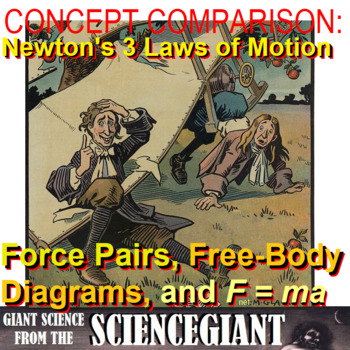
Concept Compare: Newton's Laws of Motion, Force Pairs, and Free-Body Diagrams
This Concept Comparison Frame explores Newton's Laws of Motions and introduces dynamics of unbalanced forces, including the Law of Inertia, F=ma, and action-reaction pairs using many models including free-body diagram and algebra equations.The Concept Comparison Routine is used help compare and contrast key concepts. Specifically, students use like and unlike characteristics and categories shared and not shared by two or more concepts to better understand the overall concept. Students taught usi
Subjects:
Grades:
8th - 12th, Higher Education
NGSS:
MS-PS2-2
, HS-PS2-1
, MS-PS2-5
, MS-PS2-1
, HS-PS2-3
Also included in: StayGiant Physics Bundle: Dynamics

Thermal Energy Transfer and Heating - Conduction, Convection, Radiation
What is the relationship among conduction, convection, and radiation? This concept comparison helps Ss contrast thermal energy transfer methods between solids and fluids, and between objects in contact and being isolated. The Concept Comparison Routine is designed to help students understand concepts by analyzing how they are the same and how they are different. Through use of the routine, teachers and students explore the characteristics of two or more concepts, identify the characteristics tha
Subjects:
Grades:
7th - 11th, Higher Education
Also included in: StayGiant Physics Bundle: Thermal Energy
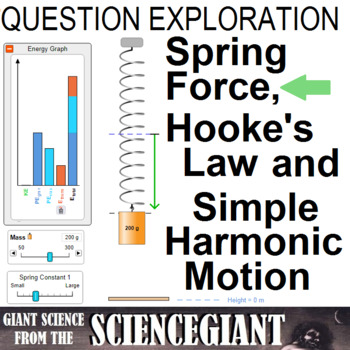
Question Exploration: Spring Force, Hooke's Law and Simple Harmonic Motion
This Question Exploration helps Ss answer the question: How does a spring scale work? Ss will identify conditions of simple harmonic motion and relate to Hooke's Law to find the spring force and spring constant. Ss will also examine the relationship between the amount a linear spring is stretched and the restoring force that acts to return the spring to its rest length. This concept is central to an understanding of elastic potential energy in mechanical systems and has implications in the study
Subjects:
Grades:
8th - 11th, Higher Education
NGSS:
HS-PS2-2
, HS-PS2-1
, HS-PS2-6

Titration Calculations Practice
12 practice problems covering acid base titrations using formula MaVa = MbVb and stoichiometry dimensional analysis. The first 5 problems students will calculate concentration and volumes using MaVa = MbVb. The remaining problems students calculate concentration, mass, and volume using dimensional analysis. Doc can be edited by adding, removing, or modifying questions to fit your lessons. Answers and solutions are provided.Google Form versionESL VersionSpanishKorean
Subjects:
Grades:
8th - 12th, Higher Education, Adult Education
Types:
Also included in: AP Chemistry Skills Reinforcement Bundle
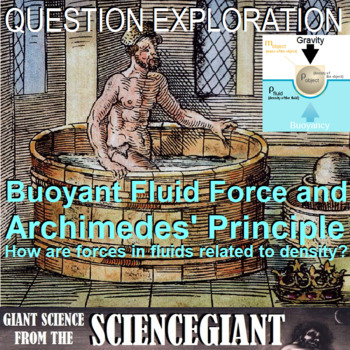
Question Exploration: What is Buoyancy and Archimedes Principle?
What is buoyant force? This Question Exploration helps students understand How are forces in fluids related to density, and explains what is Archimedes’ Principle?Question Exploration Routines are an instructional method that teachers can use to help a diverse student population understand a body of content information by carefully answering a critical question to arrive at a main idea answer. Students taught using Content Enhancement earned higher total test scores than did students taught usi
Subjects:
Grades:
9th - 12th, Higher Education
NGSS:
MS-PS2-4
, MS-PS2-2
, HS-PS2-1
Also included in: StayGiant Physics Bundle: Fluids and Hydrodynamics

Specific Heat Practice
18 problems calculating for the variables of specific heat. Students will solve for energy, mass, specific heat, and temperature changes using formula q=mcΔt. Doc can be edited by adding, removing, or modifying questions to fit your own lessons. Answers and solutions are provided.ESL versionSpanishKorean
Subjects:
Grades:
8th - 12th, Higher Education, Adult Education
Types:
Also included in: Thermochemistry Bundle

First Man Movie - Teaching Unit of Apollo 11
THIS DOES NOT INCLUDE A COPY OF THE MOVIE. This unit includes a study guide that can be used as a scavenger hunt while watching the movie with your class. It also includes a test, a crossword puzzle, and a word search. You can download this unit and edit to fit your classroom. It is a total of 14 pages.
Grades:
8th - 12th, Higher Education, Adult Education
Types:
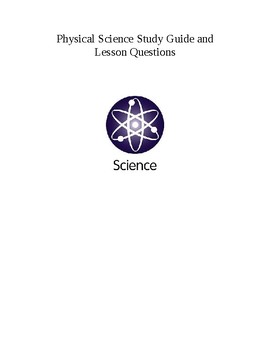
Distance Course: Physical Science Course (Notes, Questions, & Answer Keys)
Make teaching Physical Science easy with this versitile 140 page handbook that includes a complete set of notes and assessment questions! You may use this as a lecture tool, student notes, formative assessment tool, and EOC study guide, or as an entire independent study course. The Physical Science Notebook contains:Eight (8) physics lessons and eight (8) chemistry lessons Review Questions for each LessonTeacher Answer KeysJust follow each lesson day by day and it will lead you through an enti
Subjects:
Grades:
4th - 12th, Higher Education, Adult Education, Staff
Types:
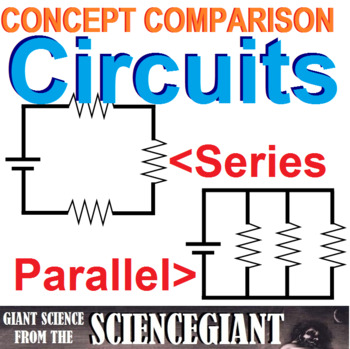
Concept Compare and Question Exploration: What is a Simple Electrical Circuit?
What is a Simple Circuit? This Concept Comparison contrasts series and parallel circuits, and the Question Exploration helps students answer What is a Simple Electrical Circuit?Question Exploration Routine is an instructional methods that teachers can use to help a diverse student population understand a body of content information by carefully answering a critical question to arrive at a main idea answer. Students taught using the question exploration routine earned higher total test scores tha
Subjects:
Grades:
9th - 12th, Higher Education
Also included in: StayGiant Physics Bundle: Electricity
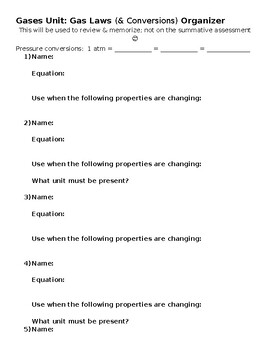
Gases Unit Notes - Gas Law Organizer
This Word document would be optimally used while students are listening to instruction in class or following along with the Gases Notes Bundle at home. This organizer provides students with a way to organize the information related to pressure conversions, as well as the six different gas laws and molar conversion that they will encounter during this unit. It is at teacher discretion whether students should use this organizer as only a study guide or while taking assessments.(This document was
Subjects:
Grades:
9th - 12th, Higher Education
Types:
Also included in: Gases Unit Notes Bundle
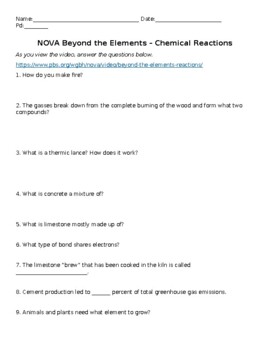
NOVA Beyond the Elements Chemical Reactions Video Worksheet
Original questions to accompany the new NOVA film - "Beyond the Elements - Chemical Reactions"
Subjects:
Grades:
5th - 12th, Higher Education
NGSS:
HS-PS1-1
, MS-PS1-2
, HS-PS1-2
, MS-PS1-1
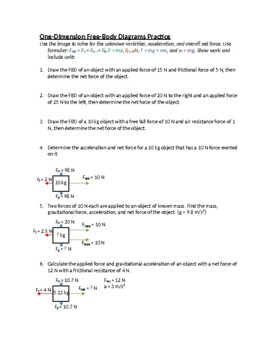
One Dimensional Free-Body Diagram Practice
13 practice problems covering one dimensional free-body diagrams. Students will use formulas: F = ma, Ff = μN, T = mg + ma, and w = mg to calculate net force, acceleration, tension, weight, etc. Problems include diagrams generated using MS Word. The doc can be edited, but doing so can mess up the diagrams. A PDF version can be provided free of charge after purchase by request. All answers and solutions are provided.
Subjects:
Grades:
8th - 12th, Higher Education, Adult Education
Types:
Also included in: Motion and Forces Physics Bundle
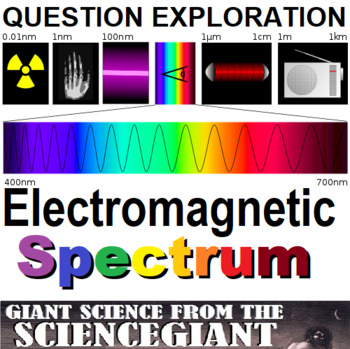
Question Exploration: What is the Electromagnetic Spectrum?
This question exploration helps explain What is the Electromagnetic Spectrum? A wave model of light is useful for explaining brightness, color, and the frequency-dependent bending of light at a surface between media. Electromagnetic radiation (e.g., radio, microwaves, light) can be modeled as a wave of changing electric and magnetic fields or as particles called photons. The wave model is useful for explaining many features of electromagnetic radiation (and the particle model explains other feat
Subjects:
Grades:
7th - 12th, Higher Education
CCSS:
Showing 1-24 of 76 results




